Expert Review
Mercedes-Benz eSprinter Panel Van (2021 - ) review
Mercedes’ biggest van goes fully electric but falls short of rivals in several key areas.
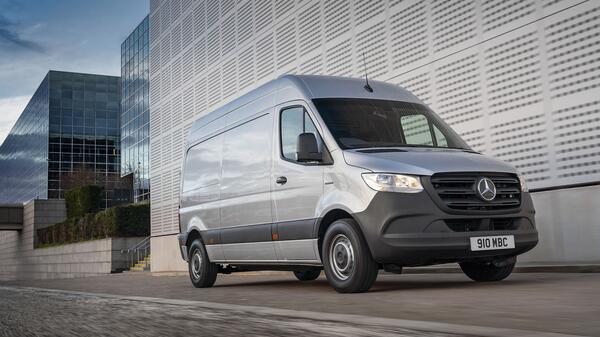

Words by: Tom Webster
Published on 7 October 2021 | 0 min read
The Auto Trader expert verdict:
3.2
The demand for large vans, and electric vans, is on the rise. The Mercedes-Benz eSprinter should be a sure-fire hit therefore, but it could well leave buyers wanting more. It falls short in the two key areas for a large electric van, with rivals offering more in terms of both payload and range. The single model makes the buying experience simple, and key features such as fast charging and a rear-view camera will make it easier to live with, but a basic cabin means it doesn’t feel as special as you might hope for a high-tech model.
Reasons to buy:
- One of only a few large electric vans available
- Smooth to drive
- Fast charging means it can be kept on the road more
Cargo & practicality
A large van is normally a big winner when it comes to the loading bay, but there are several large caveats with the electric Sprinter.
For a start, you only get one body option if you want to go electric. Mercedes has done the choosing for you, and you are restricted to the L2H2 model and nothing else. The good news is that this is the most popular model in the Sprinter range, so Mercedes reckons it should cover what most potential buyers are after.
It’s long, at 5932mm, and tall at 2687mm. This makes for a large and spacious loading bay but it also means that the Sprinter is going to struggle to make it to any charging points that are tucked away behind any height restrictions.
It’s a real shame that the payload is so poor, though, at just 731kg. That’s lower than the brand’s other electric van, the smaller Mercedes-Benz eVito. Even more importantly it is much lower than the promised payload in the rival electric vans from Citroen and Peugeot, which is in excess of 1100kg. This is particularly disappointing when you consider that Citroen and Peugeot have electrified existing and relatively old vans, while the Sprinter was designed to be battery powered from the outset.
Expert rating: 2/5
Interior
The cabin in the eSprinter is very standard fare for the model’s range, but with little in the way of frills and technology. This might well keep the price in check but it also means that the electric Sprinter doesn’t feel like the latest and most cutting-edge vehicle. Mercedes has the ability to offer a huge 26cm (10.25in) high-resolution touch screen, but the eSprinter doesn’t even get a basic screen.
The options list on the eSprinter is relatively limited, which means that you can’t get sat nav or a higher spec infotainment system, even as an added extra. Given electric vans will spend lots of their time doing urban deliveries, the lack of navigation might be an irritant to some.
The lack of screen – you only get a basic monochrome LCD display on the old-fashioned looking radio – means that all the details on the battery use are confined to the small screen on the instrument cluster in between the dials.
The rest of the cabin matches this relatively low-spec approach. There are lots of blanked off switches and not much in the way of chrome or visual details to lift the atmosphere. This doesn’t look or feel like the range-topping model.
Expert rating: 3/5
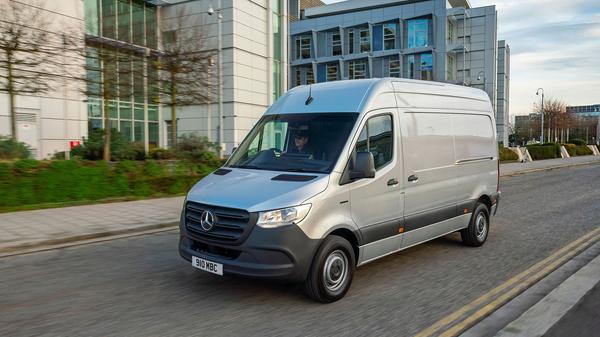
Running costs
The eSprinter sits somewhere in the middle of its class when it comes to its purchase price – it’s slightly more than the electric Citroen Relay and Peugeot Boxer, but it is cheaper than the Fiat Ducato.
This price position reflects the respective vans’ ranges, with the eSprinter promising marginally more than the Citroen and the Peugeot but not as much as the Fiat. This range is 82 miles according to the official figures, although this can be bumped up to 95 miles if you go for the 80kW option. This is only possible if you also go for the 50mph speed limiter, though.
The fast-charging model is one that will be well worth considering if you intend on topping up the charge at regular intervals throughout the day. It improves the time it takes to get from 0-80% battery capacity to just 30 minutes on a DC charger. The standard 20kW model takes two hours to do the same charge. Both versions take eight hours on an AC charger.
The other bonuses to running an electric vehicle all apply here too – there is no charge for going into the low-emission zones in various cities and there is no VED or BIK to pay.
Expert rating: 5/5
Reliability
The eSprinter’s relative newness means that there is not much in the way of back data to fall back on. However, the Sprinter itself has a fairly decent record and the comparative lack of moving parts in an electric vehicle versus one with a diesel engine should help on the reliability front.
There is a decent back-up from the official manufacturer warranty, too, with cover offered for three years and unlimited miles. The battery gets even more cover, though, with an eight-year 100,000-miles warranty as standard.
Any Mercedes van that has been serviced at a Mercedes dealer also gets free roadside assistance for up to 30 years.
Expert rating: 5/5
Performance
The electric version of the Sprinter doesn’t offer the instantaneous shove from a standstill that you get with many EVs but regardless. it does its best work at lower speeds, with a calm and still swift manner of getting to 30mph.
There are quite a few settings that impact the eSprinter’s performance and efficiency. The three driving modes are C, E and E+ - Comfort, Economy and Economy+. The latter two dial back the power and torque while Economy+ cuts the climate control functionality so as to improve the economy even further.
There are also four different settings of regenerative braking, ranging from D-, which has the most engine braking, through D, D+ and D++, which doesn’t have any at all. The number of options feels overly fussy, and it feels as though three more defined driving modes would be a better option.
Expert rating: 4/5
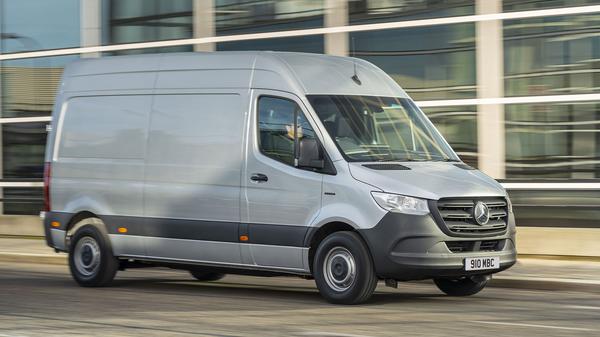
Ride and handling
The power steering on the eSprinter is electrically assisted, which means that it is light and easy to thread through urban streets. On the occasions you do choose to head out on faster roads it gets heavier, which prevents it from darting out of a lane at the slightest twitch.
The ride is typically excellent and it is wonderfully quiet, even at higher speeds thanks to the lack of engine, wind and road noise. There is a slight whine from the electric powertrain but it is much more relaxed than a diesel equivalent.
Expert rating: 5/5
Safety
Safety equipment is one area where the eSprinter offers a decent level of standard kit, with active brake assist, attention assist, which detects when the driver is getting drowsy, and crosswind assist all standard. This was sufficient to see the Sprinter range pick up a silver award – the third level down – in the first round of Euro NCAP crash testing.
There are more features available, but many of them are optional. It’s a real shame that there is just the one airbag as standard, with a passenger and side airbag for both front seats available. Speccing them would cost close to £800 though.
Although the door mirrors are a good size and offer decent visibility, blind spot assist is another optional extra. Lane keep assist and a reversing camera are both optional extras too.
Expert rating: 3/5
Equipment
There is only one trim level for the eSprinter, which is the mid-level Progressive. This means that the equipment list on the electric Sprinter is a little disappointing, with very little in the way of the glamour and tech that you often get on an electric vehicle.
It’s particularly disappointing that there is no screen in the centre of the dash, let alone any form of sat nav. What is worse is that it isn’t even available as an option.
You get the basics such as a ply-lined loading area, DAB digital radio, and keyless start, and a few luxuries including a heated driver’s seat and air conditioning, but not much more than that. It feels a bit like you have been short changed on the equipment front given the price of the eSprinter.
Expert rating: 2/5
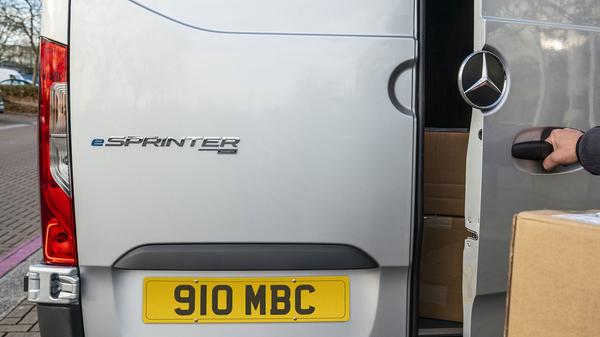
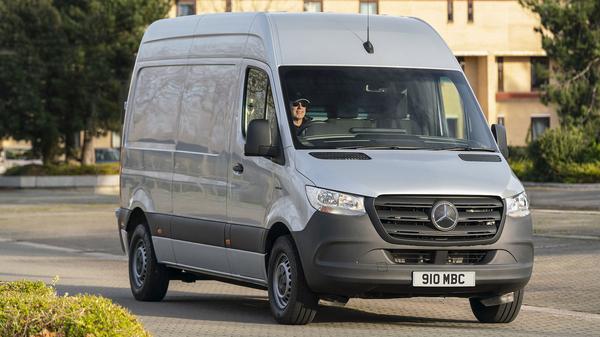
Why buy?
As a functional electric large van, the eSprinter will fulfil a lot of companies’ briefs. The range is long enough for a day of urban deliveries and the payload will cover the sort of domestic parcels that many will want to carry.
It just stops a long way short of being the best option out there, certainly in terms of payload and range, but the lack of luxury in the cabin is a pity as well. For a purpose-built electric van, it is a bit disappointing.
Expert rating: 3/5